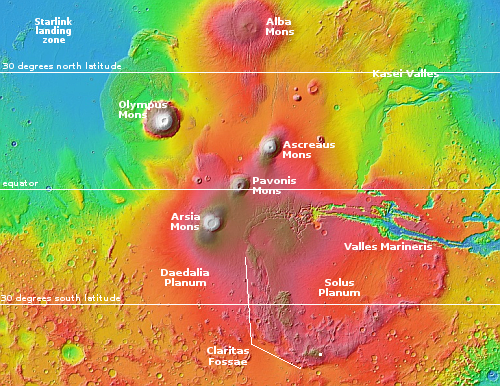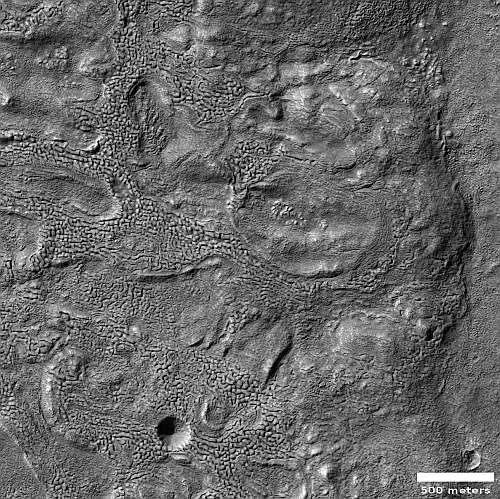Brain terrain on top of Martian mountains
Cool image time! The picture to the right, cropped and reduced to post here, was taken on March 26, 2023 by the high resolution camera on Mars Reconnaissance Orbiter (MRO). It is labeled by the scientists “Brain Terrain on Floor of Crater in Warrego Valles.”
Brain terrain is a geological feature entirely unique to Mars that remains unexplained in any way by geologists. The scientists know it is almost certainly related to near-surface ice and its sublimation into gas, but their theories as to its precise formation process remain incomplete and unconvincing, even to them.
In this case the brain terrain’s interweaving nodules seem to show flow patterns, but strangely those patterns go around depressions and hollows. Yet, the overall flow direction also seems to point downhill towards the slope on the image’s right edge.

The white dot on the overview map to the right, in the southernmost and highest part of Claritas Fossae, marks this location, in a region dubbed Warrego Valles because of the drainage patterns that flow south from these mountains. As the image’s label states, this brain terrain is located on top of what looks to be a large patch glacial material almost filling the floor of an old and very eroded 10-mile-wide crater, found near the center-left of this MRO context camera image taken on September 16, 2007. The crater itself is near the top of the mountains, at a somewhat high elevation.
This location, at 41 degrees south latitude, is in the mid-latitudes where scientists are finding ample evidence of glacial features. The brain terrain, while associated with those features, remains a mystery of its own. And this picture really doesn’t help explain it in any large measure.
On Christmas Eve 1968 three Americans became the first humans to visit another world. What they did to celebrate was unexpected and profound, and will be remembered throughout all human history. Genesis: the Story of Apollo 8, Robert Zimmerman's classic history of humanity's first journey to another world, tells that story, and it is now available as both an ebook and an audiobook, both with a foreword by Valerie Anders and a new introduction by Robert Zimmerman.
The print edition can be purchased at Amazon or from any other book seller. If you want an autographed copy the price is $60 for the hardback and $45 for the paperback, plus $8 shipping for each. Go here for purchasing details. The ebook is available everywhere for $5.99 (before discount) at amazon, or direct from my ebook publisher, ebookit. If you buy it from ebookit you don't support the big tech companies and the author gets a bigger cut much sooner.
The audiobook is also available at all these vendors, and is also free with a 30-day trial membership to Audible.
"Not simply about one mission, [Genesis] is also the history of America's quest for the moon... Zimmerman has done a masterful job of tying disparate events together into a solid account of one of America's greatest human triumphs."--San Antonio Express-News
Cool image time! The picture to the right, cropped and reduced to post here, was taken on March 26, 2023 by the high resolution camera on Mars Reconnaissance Orbiter (MRO). It is labeled by the scientists “Brain Terrain on Floor of Crater in Warrego Valles.”
Brain terrain is a geological feature entirely unique to Mars that remains unexplained in any way by geologists. The scientists know it is almost certainly related to near-surface ice and its sublimation into gas, but their theories as to its precise formation process remain incomplete and unconvincing, even to them.
In this case the brain terrain’s interweaving nodules seem to show flow patterns, but strangely those patterns go around depressions and hollows. Yet, the overall flow direction also seems to point downhill towards the slope on the image’s right edge.

The white dot on the overview map to the right, in the southernmost and highest part of Claritas Fossae, marks this location, in a region dubbed Warrego Valles because of the drainage patterns that flow south from these mountains. As the image’s label states, this brain terrain is located on top of what looks to be a large patch glacial material almost filling the floor of an old and very eroded 10-mile-wide crater, found near the center-left of this MRO context camera image taken on September 16, 2007. The crater itself is near the top of the mountains, at a somewhat high elevation.
This location, at 41 degrees south latitude, is in the mid-latitudes where scientists are finding ample evidence of glacial features. The brain terrain, while associated with those features, remains a mystery of its own. And this picture really doesn’t help explain it in any large measure.
On Christmas Eve 1968 three Americans became the first humans to visit another world. What they did to celebrate was unexpected and profound, and will be remembered throughout all human history. Genesis: the Story of Apollo 8, Robert Zimmerman's classic history of humanity's first journey to another world, tells that story, and it is now available as both an ebook and an audiobook, both with a foreword by Valerie Anders and a new introduction by Robert Zimmerman.
The print edition can be purchased at Amazon or from any other book seller. If you want an autographed copy the price is $60 for the hardback and $45 for the paperback, plus $8 shipping for each. Go here for purchasing details. The ebook is available everywhere for $5.99 (before discount) at amazon, or direct from my ebook publisher, ebookit. If you buy it from ebookit you don't support the big tech companies and the author gets a bigger cut much sooner.
The audiobook is also available at all these vendors, and is also free with a 30-day trial membership to Audible.
"Not simply about one mission, [Genesis] is also the history of America's quest for the moon... Zimmerman has done a masterful job of tying disparate events together into a solid account of one of America's greatest human triumphs."--San Antonio Express-News



Those features appear to have some depth to them. Look at the original image of the larger impact crater at the bottom of the cropped image. The features at the lower right-hand perimeter appear to extend downward into the crater wall for an appreciable distance as though the edge of the crater wall had sliced through them. They also appear to be whitish-colored in the interstitial space between the individual raised lumps of the features.
This time it doesn’t look like anything I’ve seen in melted/sublimated snowscapes; it just looks weird.
Blackwing1:
I would submit that the crater is not an impact, but a sinkhole. The ‘brain terrain’ was clearly pre-existing, but where is the impact ejecta?
The meteor impact in the picture is a symmetrical cone with no ejecta at the rim, in fact I see no loose material like Sandune‘s anywhere. Perhaps an impact pressure wave fractured the hard ground and those cracks widened out overtime? I’ve broken slate, glass, and homemade toffee… But the only thing that comes close to this type of fracturing is heat treated window glass.
At least no one‘s claiming that it’s an ancient Martian housing complex…
Upon further examination, black wing has a point on the slope, and the whitish lumps. In the crater you can see the white extends down the wall so it’s not just a surface phenomenon.
It looked familiar but I couldn’t quite place it, then I remembered a oat bran cereal? floating in milk from when I was a child. A log jam a frozen volcanic pumas flowing downhill between soft mountains that most have all eroded away leaving depressions.
Have you ever squeezed Play-Doh through the hair maker/spaghetti press? When you squeeze it together to make a solid lump again it retains the individual shape even though it’s in a mass. Like a river of viscous cat turds from a mud volcano…
Leave the mind flayers be.